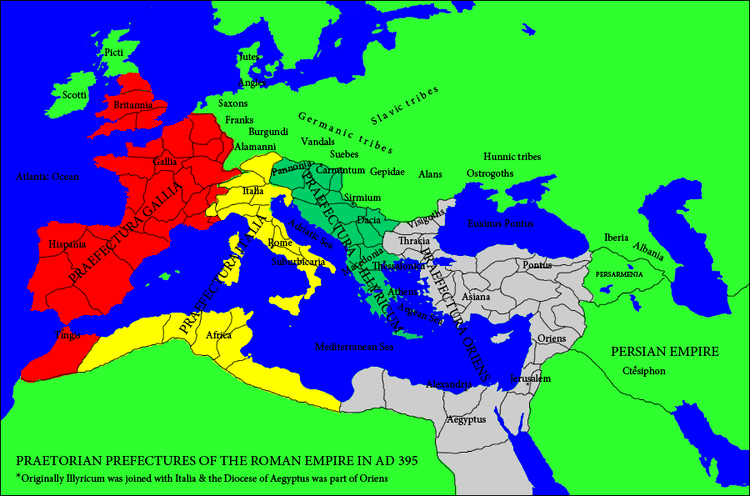337–584 → → Historical era Late Antiquity Foundation of Exarchate of Ravenna 584 | Established 337 | |
 | ||
Today part of Algeria Austria Croatia France Germany Italy Libya Slovenia Switzerland Tunisia Vatican City Malta | ||
Praetorian prefecture of italy
The praetorian prefecture of Italy (Latin: praefectura praetorio Italiae, in its full form (until 356) praefectura praetorio Italiae, Illyrici et Africae) was one of four Praetorian prefectures into which the Late Roman Empire was divided. It comprised the Italian peninsula, the Western Balkans, the Danubian provinces and parts of North Africa. The Prefecture's seat moved from Rome to Milan and finally, Ravenna.
Contents
- Praetorian prefecture of italy
- Structure and history
- List of known praefecti praetorio Italiae et Africae
- Western Empire
- Germanic rule
- East Roman rule
- References
Structure and history
The prefecture was established in the division of the Empire after the death of Constantine the Great in 337, and was made up of dioceses. Initially these were the Diocese of Africa, the Diocese of Italy, the Diocese of Pannonia, the Diocese of Dacia and the Diocese of Macedonia (the last two were until c. 327 united in the Diocese of Moesia). Eventually the Diocese of Italy was split in two, the Diocese of Suburbicarian Italy (Italia suburbicaria: "Italy under the City", also referred to as "Diocese of the City of Rome") and the Diocese of Annonarian Italy (Italia annonaria: "provisioning Italy").
In 347, the praetorian prefecture of Illyricum was established, comprising the dioceses of Pannonia, Dacia and Macedonia. Vulcaius Rufinus was the prefect, 347-352. The new prefecture was abolished in 361 by Julian and reestablished in 375 by Gratian. Its territory was contested between the two halves of the Empire, until the final partition in 395, when the Diocese of Pannonia was split off from the Illyricum and joined to the Western Empire and the prefecture of Italy as the Diocese of Illyricum.
Despite the end of the Western Empire in 476, the Germanic successor states under Odoacer and Theodoric the Great continued to use the Roman administrative machinery, as well as being nominal subjects of the Eastern emperor at Constantinople. The Prefecture thus survived, and came again into Roman hands after Justinian's Gothic War. However, with the Lombard invasion in 568, Roman rule became reduced to fragmented and isolated territories, and the Prefecture gave its place to the Exarchate of Ravenna, established by the emperor Maurice.
Prefects continue however to be attested until well into the 7th century. The last attested holder occurs in 639, and a couple of seals bearing the title eparchos ("prefect" in Greek) survive from the late 7th century, although it has been suggested that they are a misprint for exarchos ("exarch").
List of known praefecti praetorio Italiae et Africae
+ Lucius Pupius Pacatianus (334-335)
Western Empire
Germanic rule
Under Odoacer:
Under the Ostrogoths:
